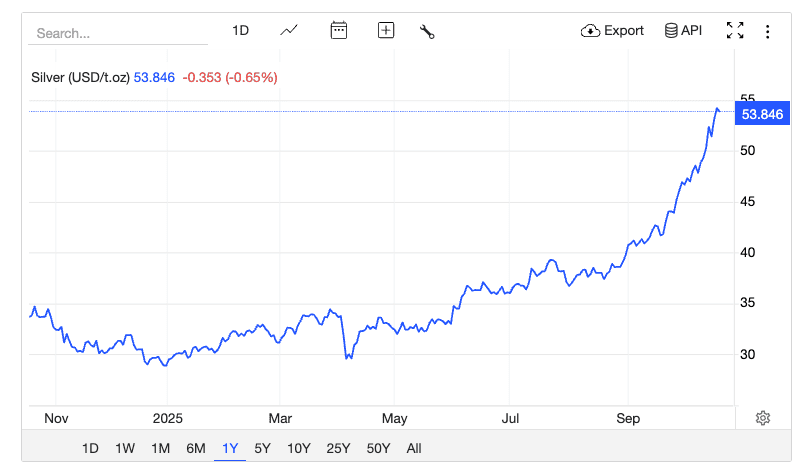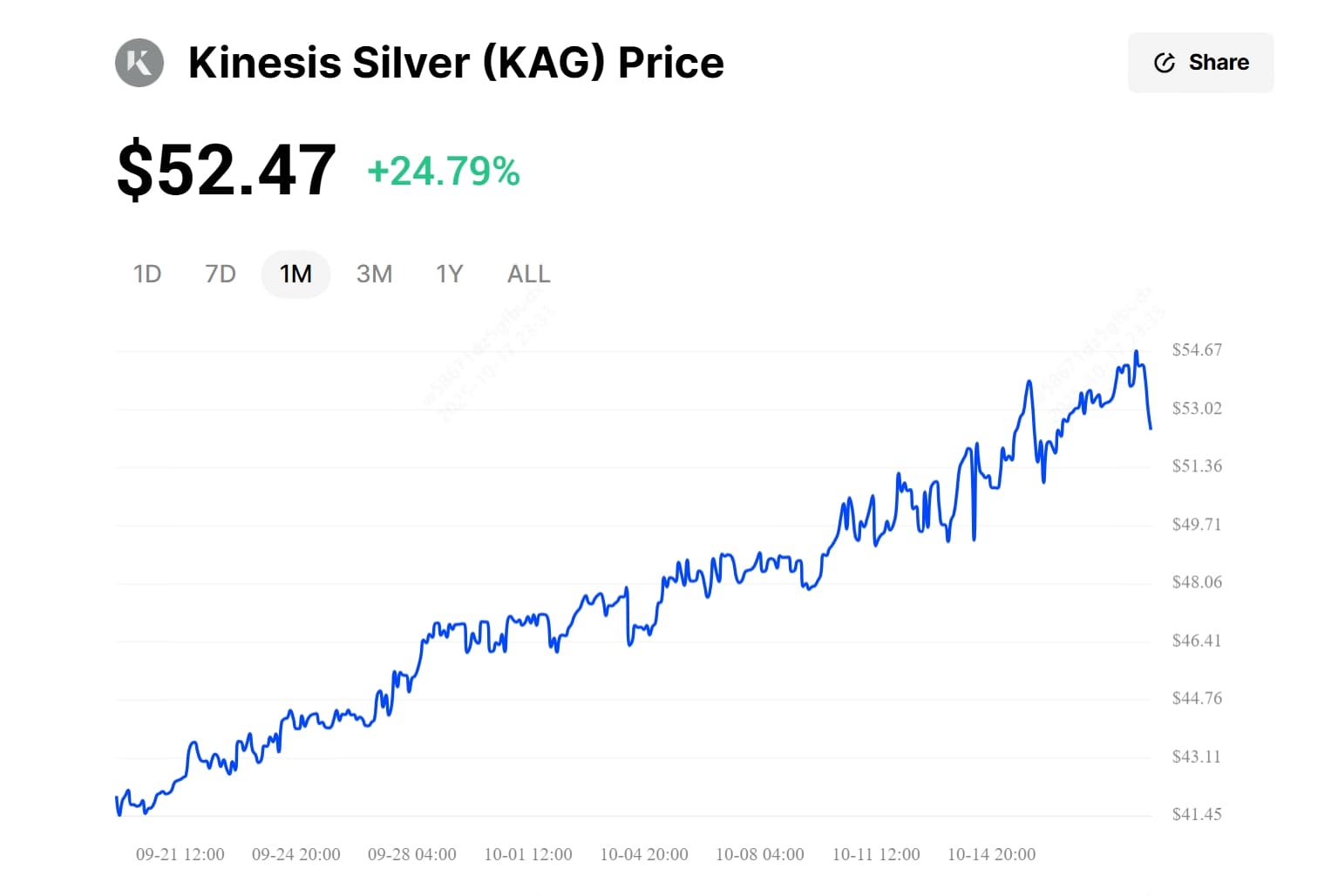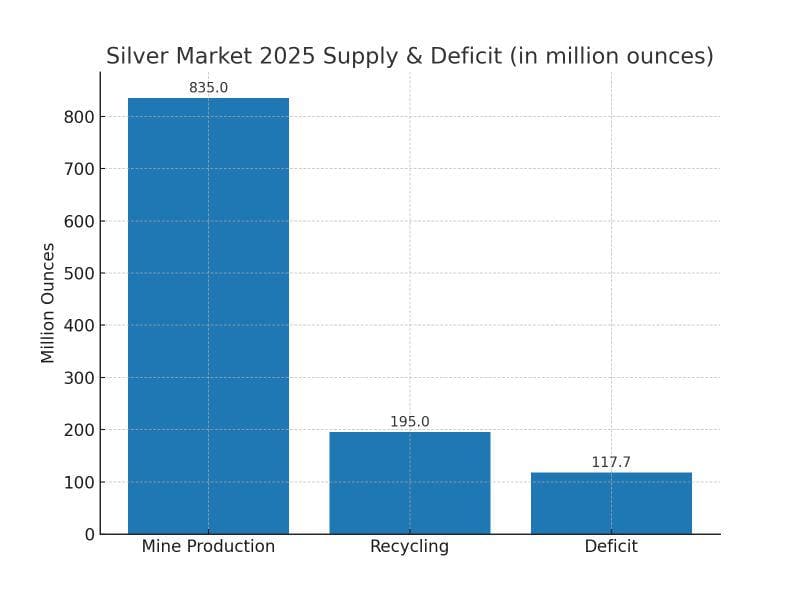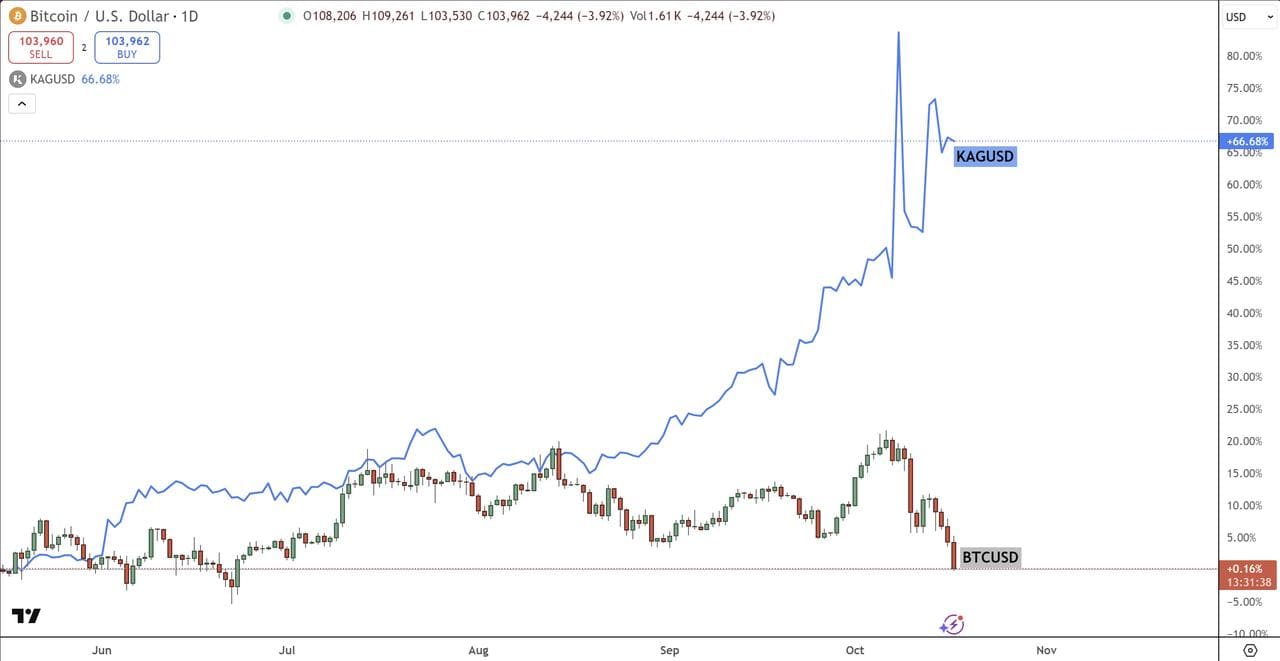Silver-backed cryptocurrencies are gaining traction, even as volumes lag
gold-backed assets, driven by tightening supply, rising industrial demand across solar, EVs and electronics, and the broader tokenization of real-world assets.
As of October 17, 2025, interest has accelerated with physical silver at $53.84 per ounce. The sector’s market cap has moved above $200 million, with trading concentrated in
Kinesis Silver (KAG), Silver Token (XAGX) and
Gram Silver (GRAMS) as traders seek on-chain exposure to redeemable, physically backed assets.
While
Bitcoin set fresh highs in early October before pulling back, silver has outpaced many risk assets on persistent supply tightness; with the gold to silver ratio in the mid 80s, analysts see relative value in silver.
While Bitcoin also set a new all-time high above $126,000 on October 6, 2025 before easing toward roughly $104,000 by October 17, silver has shown notable outperformance, with spot prices pushing toward the mid-$50s and safe-haven flows accelerating.
On 10 October, a key geopolitical issue caused heightened risk aversion, which helped propel both gold and silver to record levels.
In this article, we explore what silver-backed tokens are, how they work and their real-world applications, as well as the macroeconomic forces behind the latest rally.
What Are Silver-Backed Tokens?
KAG Price | Source:
BingX
Silver-backed crypto tokens give you on-chain exposure to real silver. Each token represents a direct claim on metal held in insured, audited vaults, typically pegged 1:1 to a set amount of silver so you keep the metal’s price exposure and, in many cases, can redeem for bullion under the platform’s terms.
The main names here are KAG, which maps to one ounce of fully allocated silver stored across multiple jurisdictions, XAGX, which mirrors one ounce on
Avalanche, and GRAMS, which tracks one gram on Avalanche and
Polygon with a mint and burn design to keep parity.
Unlike traditional silver ETFs with market-hour limits, these tokens trade around the clock and move easily between wallets with final settlement on chain.
Over the past 30 days the trend has strengthened without turning frothy. KAG is up around 30% with a market cap over $200 million. XAGX has climbed a bit over 40% and remains a small cap with a fully diluted valuation in the low tens of millions. GRAMS has advanced about 27% with a fully diluted valuation in the mid single-digit millions.
The Mechanics of Silver Tokenization
The process starts with investment-grade bullion stored at professional custodians. Bars are serialized and reconciled against token supply. Tokens are minted on public blockchains (e.g., Ethereum, Polygon, Avalanche or a Stellar-derived chain) under
smart contracts that define issuance, burning, reserve transparency and redemption.
KAG (Kinesis Silver)
Fully allocated reserves via the Allocated Bullion Exchange (ABX), insured storage on six continents, and a monthly, debt-free yield paid in KAG sourced from a share of global transaction fees for users who hold metal on the platform. Physical redemption starts at 200 ounces through localized hubs.
Silver Token (XAGX) & Silver (GRAMS)
One-to-one collateralization (per ounce or per gram) with mint-and-burn logic to maintain price parity to spot silver, and on-chain traceability for issuance and redemptions.
Storage and insurance fees, where applicable, are typically outlined by each issuer. Redemption requires burning the corresponding tokens and may include minimum quantities and shipping or pickup arrangements.
What Are the Use Cases for Silver-Backed Tokens?
Silver-backed tokens extend beyond passive holding and slot into multiple workflows:
1. Hedging against volatility
A lower beta pocket inside the crypto stack that helps you de-risk without leaving on-chain markets. Traders rotate from high-volatility pairs into KAG, XAGX, or GRAMS during drawdowns, then rotate back when risk appetite returns. This can smooth PnL and reduce liquidation risk on leveraged positions.
2. DeFi integration
Where supported, metal-backed tokens can be posted as collateral to borrow stables or to structure delta-neutral strategies, so you keep silver exposure while unlocking liquidity. KAG additionally pays a monthly, debt-free
yield to holders on its native platform. Providing liquidity in silver pairs can earn fees, but it introduces impermanent loss, so position sizing and fee math matter.
3. Cross-border transfers and spending
Settlement in minutes, 24/7, with transparent on-chain proofs. Wallet-to-wallet transfers make remittances simpler than shipping bars or wires. With KAG’s virtual card you can spend metal-backed value at the point of sale, while XAGX and GRAMS move easily between EVM wallets for quick peer payments.
Emerging experiments include real-world asset (
RWA) indices that bundle multiple metals, multi-chain issuance to improve routing between Avalanche and Polygon, and richer proof-of-reserves dashboards to strengthen the link between the circulating supply and vaulted metal.
Momentum through October reflects a confluence of macro forces:
• Structural Deficits: The World Silver Survey 2025 highlights a fifth consecutive annual shortfall (roughly 117 million ounces), with 2024’s deficit near 149 million ounces as solar and EV demand hit records. Mine output around ~835 million ounces trails demand above 900 million, and recycling only partially offsets the gap.
• Industrial Tailwinds: Solar alone could exceed 400 million ounces annually by 2030, with EVs and advanced electronics adding steady baseline demand.
• Inflation and Policy: Anticipated rate cuts into late 2025/early 2026 and lingering inflation support real-asset allocations. Silver-backed ETFs reportedly added ~95 million ounces in H1 2025, tightening available inventories, while heightened geopolitical tensions have pushed gold and silver higher.
• Trade and Geopolitics: Renewed tariff regimes and supply-chain frictions lift hedging demand and can constrain production, particularly in key producing regions; these geopolitical flashpoints have further accelerated flows into gold and silver.
Comparing KAG and BTC Performance
Silver vs. Bitcoin performance YTD | Source:
TradingView
Both silver and Bitcoin offer alternatives to fiat, but their drivers have diverged. Reuters reports that silver and gold is rising on industrial demand and safe haven flows, while mid October geopolitical tensions are denting risk appetite for Bitcoin and adding to its volatility. For diversified portfolios, silver backed tokens can connect tangible collateral with crypto-native liquidity.
With silver near multi-year highs and tokenized metals gaining traction, you can access silver backed exposure on mainstream crypto venues and issuer platforms. Projects such as KAG, XAGX and GRAMS provide physically backed options. If you want price exposure without metal custody, sXAG offers a synthetic alternative for active traders.
Conclusion
Looking ahead, silver backed tokens appear well positioned to benefit from clearer regulation, stronger proof of reserves tooling and broader RWA adoption. Institutional and retail inflows, combined with persistent supply deficits and expanding industrial use, could sustain the theme into 2026 and beyond.
Risks remain, including issuer and custody concentration, smart contract vulnerabilities, liquidity fragmentation and shifting policy paths.
For investors who want tangible collateral with crypto native flexibility, silver backed tokens offer a way to blend stability, composability and 24/7 market access in an increasingly tokenized economy.
Related Reading






